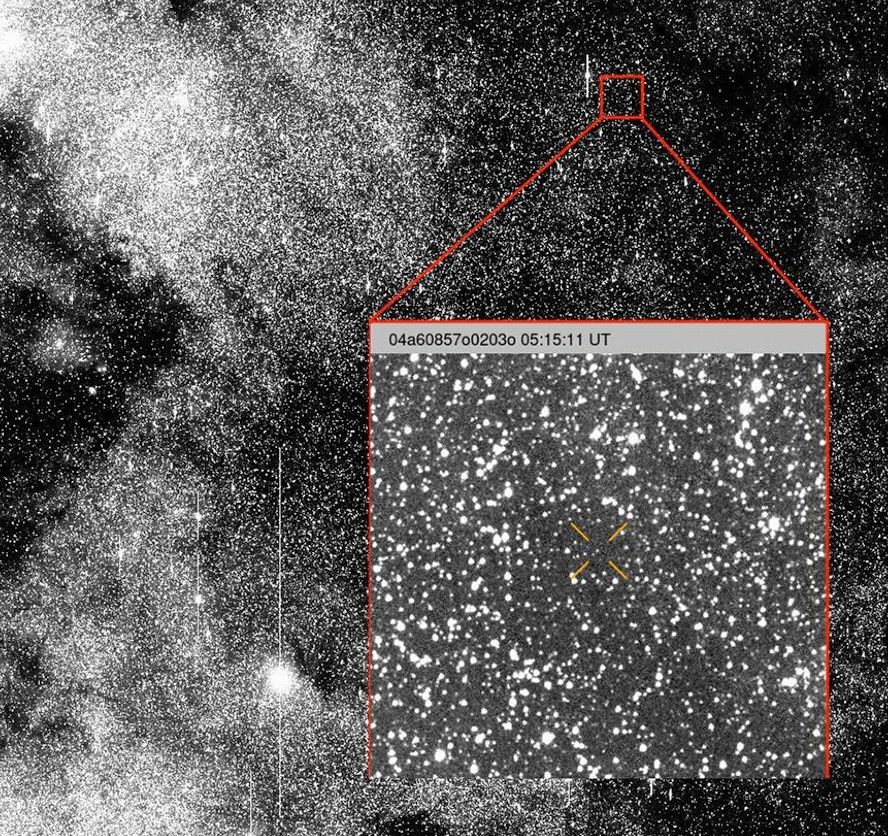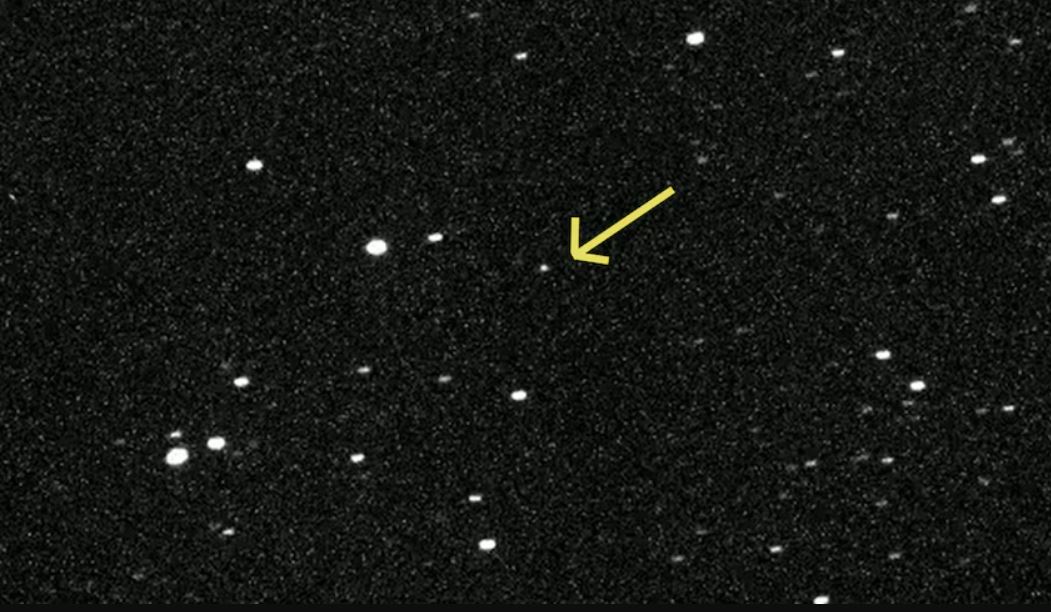Just after midnight in a part of Planet Earth known as Massachusetts, a team of scientists who track comets and minor planets in the solar system announced that they had spotted something new: a spark in the southern sky, visible in the data they were getting from a telescope in Chile.
The telescope, high in the Atacama Desert, is tasked with searching for objects that might collide with Earth. “We at the Minor Planet Center have the role to collect the information and also to post it quickly, almost in real time, on our website if the object is somehow interesting,” said Peter Veres, a Harvard astronomer sometimes described as an air-traffic controller for the solar system.
So at 1.15am local time on July 1, the discovery was announced. “Observers around the world quickly gathered their telescopes,” Veres said.

The possible comet 3I/Atlas when it was discovered on July 1
ATLAS/UNIVERSITY OF HAWAII/NASA
Soon, astronomers concluded that the object had come from interstellar space, that it would not come within 170 million miles of Earth and that it was, in all likelihood, a sort of cosmic iceberg billions of years old, ejected from the frosty outer limits of another star system and now zipping along at 118,000 miles an hour, the fastest object ever sighted in our solar system.
But there was also another theory that was soon being advanced by the Harvard astronomer Avi Loeb: that this object could be an alien probe, sent on a reconnaissance mission through our solar system on a course that kept it, deliberately, out of reach of our fastest rockets.
It is only the third interstellar object ever recorded passing through the solar system. The first, that was named Oumuamua, was sighted in 2017. A second, 2I/Borisov, was spotted in 2019 by a telescope maker in Crimea named Gennadiy Borisov. This latest visitor was sighted by a telescope run by Atlas, an early warning system funded by Nasathat is designed to detect asteroids heading towards Earth. It has been named 3I/Atlas, the 3I standing for “3 Interstellar”.
Loeb is recognised by fellow astronomers for his work on the evolution of the first stars, but he gained a global following in 2018 when he and a colleague published a paper suggesting that Oumuamua was a solar sail created by an alien civilisation, floating like driftwood through interstellar space, or perhaps even an alien probe dispatched on a scouting mission to our solar system.
On July 2, 24 hours after Harvard’s Minor Planets Center announced the sighting of 3I/Atlas, Loeb woke at 2am to appear on a late-night radio show called Coast to Coast. After he got off air, “one of the listeners wrote to me and said: ‘There is a potential new object,’” he said.
Loeb began posting essays on the 3I/Atlas. “They have received a quarter of a million views,” he said. “Can you believe it? It’s not a TikTok video. These are essays of 1,000 words or more.”

Avi Loeb, a Harvard University astrophysicist
ANIBAL MARTEL/ANADOLU AGENCY VIA GETTY IMAGES
Several things about 3I/Atlas struck him as unusual. “There is no trail of dust,” he said. Its trajectory lines up, to within five degrees, to the ecliptic plane, the orbital plane on which the Earth and most of the other planets in the solar system track around the sun, he added. “The chance of it being on that plane is one in 500.” Its timing meant that it would come close to three planets: Jupiter, Mars and Venus. This, he said, “raises the question of whether this trajectory was designed”.
It would pass closest to the sun on October 29 but “we won’t be able to observe it because the sun will be in the way”, he said. “It’s an interesting coincidence.” Its speed is expected to increase, as it nears the sun, to about 152,000 miles per hour — and when you factor in the speed of the Earth, which is moving in the opposite direction around the sun, “that’s three times faster than our fastest rockets”, he said.

The 3I/Atlas, an object from another solar system
On a scale of one to ten, where ten represents a definite piece of alien technology, he still only gives it “a four so far”, he said. But he recently posted an essay on the Medium platform, asking what humanity should do “if the new interstellar object 3I/ATLAS is a spacecraft, guided to send mini-probes that will arrive at Earth and other planets in the coming months”.
He has a 15-point plan.
One of his followers is already trading against the stock market, believing it will crash if the probe theory proves true, he said. Markets would crash “because of the uncertainty”, he said, adding: “We might feel like the Iranian air-defence system, when the B2 bombers were flying overhead and we can’t do anything about it.”
Other astronomers think that the object is a comet: a fascinating thing to see but not proof, at last, that mankind is not alone in the universe. Loeb is “a super bright guy”, said Jonathan McDowell, an astronomer at the Harvard–Smithsonian Center for Astrophysics. He noted that Loeb had led Breakthrough Starshot, a project to send a probe to the nearest star system, Alpha Centauri. “Then when Oumuamua came in, he asked the very reasonable question: if one of my probes went through Alpha Centauri, wouldn’t it look just like this? The answer turns out to be no.”
Oumuamua was long and flat. Veres, of the Minor Planets Center, said that it was “interesting because of its shape and its odd motion”. It did not have the fuzzy halo of gas and dust that comets usually give off as they near the sun and heat up, and it seemed to accelerate in a manner that could not be accounted for “purely by gravity”, Veres said. “That led to some, I would say speculative ideas by Professor Loeb … that it’s a solar sail or probe.”
• Scientists challenge theory that mystery object was alien ship
The second interstellar object to be spotted, Borisov, behaved more like a comet, Veres said. This third object was spotted when it was about 418 million miles from the sun. Its size is still hotly debated, though it is thought to be somewhere between 200 and 5,000 metres across, he said.
Its trajectory, zipping through the solar system against the flow of the circling planets, is certainly interesting, but Veres notes that it is only the third such object ever spotted. “The previous two objects were on totally random angles,” he said. Once 30 or 100 have been tracked, it will be easier to see what is ordinary for an interstellar comet, he said.
But there are still unanswered questions. “Now it’s like, [260 million] miles from the sun. It’s getting warmer … but it’s still not very active,” he said. “There is still no tail.” This, he said, was “fuel for those speculative ideas by Professor Loeb”.
Veres thinks that the lack of a halo of gas and dust might be because it has developed a hard crust as it crossed interstellar space and was “baked”, though not in a warming sense, by cosmic rays. Perhaps as it nears the sun, this crust “will peel off and suddenly we’ll see a lot of activity”.
John Forbes, a computational astronomer at the University of Canterbury in New Zealand, believes that 3I/Atlas does have a halo but that it is hard to see, because the comet is still travelling in our general direction. “The tail is pointing a little away from us,” he said. “For my money, it’s a really interesting object but it looks an awful lot like a comet.”

The object will pass three planets while travelling too fast for our fastest rockets to reach it
It has come from nearer the centre of the Milky Way, where there are stars formed billions of years before our sun. These older stars are composed of lighter elements, and have fewer metals in them, “because metals themselves are produced by stars evolving and exploding”, said Forbes.
As stars form, a flat disc of dust and gas swirls around them and resolves into planets as well as lumps of ice and dust that get ejected into interstellar space. McDowell described 3I/Atlas as an interstellar iceberg with a composition unlike any ice on Earth, “wandering the galaxy for yonks” and now, as it nears us, “barrelling along in a cloud of its own steam”.
Loeb thinks that whatever it is, its passage through our solar system represents a huge opportunity to get the general public excited about science. “It entered the outskirts of our solar system, the edge of the so-called Oort Cloud, 8,000 years ago,” he said. “That was when humans started to document their history. It came within 1,000 times of the [distance between the Earth and the sun] 80 years ago.” Eight years ago, it passed through the Kuiper Belt, just beyond the orbit of Neptune, he said. Now it is a speck in the heavens, moving steadily north across the night sky.
